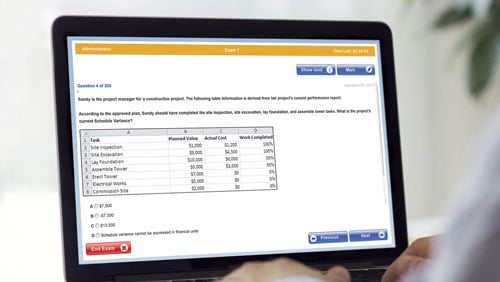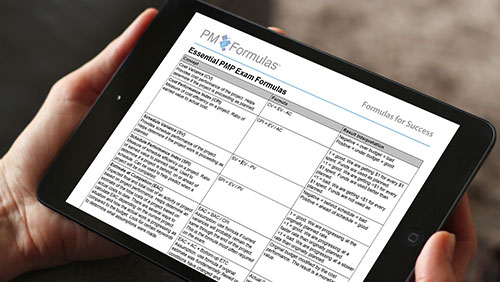The Three R's You need to Pass the PMP® Certification Exam
 As part of the process of preparing to take the Project Management Professional (PMP®) Exam you have most likely read about the use of a Responsibility Assignment Matrix (RAM), Roles and Responsibilities, and the Resource Breakdown Structure (RBS). Each of these tools & techniques are discussed within A Guide to the Project Management Body of Knowledge (PMBOK® Guide), the globally recognized standard and guide for the project management profession. In this article, we not only look at each of these tools & techniques individually but also how they interact with each other.
As part of the process of preparing to take the Project Management Professional (PMP®) Exam you have most likely read about the use of a Responsibility Assignment Matrix (RAM), Roles and Responsibilities, and the Resource Breakdown Structure (RBS). Each of these tools & techniques are discussed within A Guide to the Project Management Body of Knowledge (PMBOK® Guide), the globally recognized standard and guide for the project management profession. In this article, we not only look at each of these tools & techniques individually but also how they interact with each other.
What is a Responsibility Assignment Matrix (RAM)?
It is a tool used as part of the Plan Human Resource Management process that relates the organizational breakdown structure (OBS) to the work breakdown structure (WBS) and is used to ensure each project activity is assigned a specific resource. A RAM can be used at a high level, a low level, or a combination of both depending on the size and complexity of the project. A high-level RAM may show that Company A has been hired to complete the engineering portion of a project. A low-level RAM may show that Joe Smith of Company A will be completing the electrical engineering for the design portion of the project.
What is a RACI Chart?
One of the most widely known and used type of RAM is the RACI chart. RACI stands for Responsible, Accountable, Consult, and Inform. A RACI chart is simply a table with project activities listed along the left and specific individuals or groups identified across the top. This creates a grid where each activity and individual or group intersect. An R, A, C, or I can be placed in each of the intersecting boxes and at least one accountable individual or group is assigned to each project activity. For large activities there may need to be more than one individual responsible for completing the work. There can be multiple individuals or groups who need to be consulted or informed, but be careful to make sure that each is identified correctly so that not too many unnecessary individuals or groups are being consulted when they may just want to be informed.
What are Roles and Responsibilities?
They are used to define the project role, authority, responsibilities, and competencies required for the role. Clearly defining and documenting the specific Roles and Responsibilities necessary for each project resource are essential ingredients of an effective Human Resource Management Plan. The best way to determine the specific responsibilities required of each role on a project is to document these roles in the form of specific job descriptions that must be matched with specific project team members in order to properly execute the role’s responsibilities.
The four key items to be addressed when developing Roles and Responsibilities are role, authority, responsibility, and competency. Role is the function an assigned person would take on such as designer, engineer, or tester. As part of a role it is also important to define the authority, responsibilities, and boundaries of the role. Authority is the right to make decisions, sign approvals, apply resources, accept deliverables, and influence others to complete project activities. Responsibility is the assigned tasks and work the individual is expected to complete. When developing roles and responsibilities it is important that the authority and responsibility match. For example, if an engineer is responsible for making technical decisions it is important they have the authority to implement those decisions. Competency is the skill set and experience required to complete assigned project activities. If the wrong competency is assigned to a role project progress can be hindered by some activities not being performed.
What is the Resource Breakdown Structure (RBS)?
It is a graphical representation of the hierarchical structure of resources by category and resource type where each level is broken down until it is small enough to be used in conjunction with the work breakdown structure (WBS). The goal is to have all resources on a project, not only human resources, linked to specific activities in the WBS in order to plan, monitor, and control the project work. Being able to link resources back to the WBS is essential in ensuring that each activity will be successfully performed.
One thing to remember when taking the PMP Exam is that the acronym RBS has two meanings in the world of project management; Resource Breakdown Structure and Risk Breakdown Structure. If you read the questions carefully and understand the context of the question context (i.e., are they asking about resources or risks?) you should not encounter any problems.
How do the RAM, R&R, and RBS interact?
The RBS will provide the project manager with information concerning the resources required to complete the project work. Once the RBS is decomposed to the same level as the WBS then identified resources can be linked to specific activities. A RACI chart can then be developed based on the identified resources in the RBS and the activities that need to be completed in the WBS. The documented Roles and Responsibilities provides the project manager with specific information such as the responsibility, authority, and competency level of the role that each human resource is assigned to. This also helps the Project Manager complete the RACI chart because it provides them with important information such as making someone responsible or accountable for an activity fitting within the role they fill.
In this article we were able to take a brief look at three very important project management topics and how they interact with each other in practice. A popular RAM, the RACI chart, is an extremely useful tool used to identify who is accountable or responsible for or needs to be consulted or informed with regard to specific project activities. Roles and Responsibilities can be thought of as job descriptions that define the role itself along with the authority needed to perform the role, the responsibilities of the role, and the competencies required by the role. The RBS graphically displays what resources are necessary for successful completion of the project, broken down by both resource category and resource type. For the exam, it is important that you understand not only how and when to use each of these tools & techniques, but also how they interact with each other.
Watch this YouTube video "The Short Guide to Becoming a PMP" for more tips on how to prepare for your PMP® exam.


